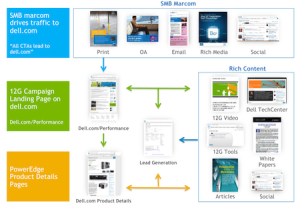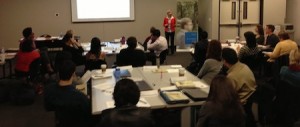Go to article
Colleen Jones Talks with Content Visionaries at Dell
JUL 17 2013
Smart companies recognize the importance of smart content.
Diane Bunton, Marketing Director for Global Online Content Operations at Dell Inc., explains
“Dell has a practical, no-nonsense approach to helping customers do more. We want our content to be relevant for the decisions our customers are making.”
But how do you ensure a strategic approach for each and every piece of content across your entire organization, especially if it’s large? In other words, how do you make enterprise content strategy work? It’s a question facing enterprises across industries and around the world.
At the Fortune 50 technology leader Dell, the company’s portfolio of end-to-end solutions demands compelling content for products, services and markets worldwide—from marketing all the way through technical support. Getting all of that content right is a massive, complex challenge.
So Dell’s leadership tackled the question head on. Their answer? Build a content strategy that scales.
Let’s take a closer look at the content challenges Dell faces and how content visionaries such as Diane are overcoming them by forging a united vision for content strategy and enabling global teams to implement that vision.
THE CHALLENGES THAT SPARKED A CONTENT STRATEGY SOLUTION
Because it covers an extensive range of products, services and markets, content creation at Dell involves hundreds of employees and takes place all over the world, from the company’s Round Rock, Texas, headquarters to the UK, Japan and beyond.
Until recently, operations had been segmented around business units, with content following as an extension of that segmentation. As is often the case in large enterprises, content at Dell was being produced in decentralized silos that didn’t always coordinate. What makes Dell different from many large companies? Thought leaders realized there had to be a better approach—and that approach involved content strategy.
Brennan Dell, the company’s Director of Marketing Education, explains that he and others came together and discussed a different philosophy…
“Let’s rein this back in, and not only decrease the number of people with the ability to create content, but sync up our approach and get more consistent about our strategy for content creation and maintenance.”
Of course, taking a content-first approach means more people have to collaborate across different teams. Aaron Burgess, Dell’s Senior Manager for Content Strategy, explains
“If we are building an interface that is just one company collecting content from all these different silos into one presentation layer, then holy cow, we need a plan for how we work together.”
Dell started to do things differently on key projects—with much success. One big win was the content strategy to support the launch of Dell’s 12th Generation PowerEdge Servers. The right promotional content in campaigns, through social media, and on the Dell.com home page drove people to in-depth content about the new PowerEdge launch on Dell.com.

This sample flow shows how Dell strategically planned the PowerEdge content that customers needed. Dell sought to repeat successes like this by scaling content strategy.
Why did this success happen? Because of content strategy. Instead of operating in silos, teams collaborated and coordinated with one another from start to finish.
“We realized this is the way we should be doing it in the future,” Brennan notes.
That realization raised a new question and a challenge: How do you scale a strategic approach for each and every content project or effort at a global enterprise? With so many people involved in the planning, creating, and building / publishing phases of content, the challenge is not small. That’s where my team and I collaborated with Aaron, Brennan, and Diane.
Let’s take a closer look at the approach and insights from our recent collaboration with Dell that might help your organization adopt content strategy.
TRAINING AND TOOLS: SECRETS TO SCALING CONTENT STRATEGY
After talking with stakeholders from several different Dell content teams, we realized that scaling content strategy would take alignment around two things:
- A core vision for content strategy.
- A practical framework and supporting tools for implementing content strategy.
As Diane notes
“We have multiple marketing organizations—search, video, product, and more—but we need our customers to have a similar experience, no matter where content is coming from. We wanted to get all of our content teams aligned on the basic goals.”
So, together, that’s what we did. The key? A two-part system of training and tools.
1. In-Person and Remote Training
We developed an in-person and remote training course for Dell’s headquarters and key global markets. The goals included articulating the value of content strategy, offering a unique vision for it at Dell, and empowering people to apply it. Brennan confirms,
“It was a good level-set across Dell’s online division on the importance of content strategy, why we need to have a content strategy brief, and what goes into creating a good content environment and user experience.”
A few elements of the training made it work well: relevance, credibility, and case studies.
Relevance
At Dell, “content” often translates to “marketing,” so the training focused on content strategy from the perspective of marketers. As Aaron notes,
“The course was was speaking their [marketers'] language right from the start.”
Credibility
I personally led each session with a wide variety of professionals across different teams at Dell. Not only did I enjoy the insightful questions and diverse perspectives, but my background enhanced the training’s credibility. Diane points out,
“People appreciated meeting the author of Clout, a thought leader in the field.”

Professionals from different teams and with different perspectives at Dell came together for training in content strategy.
Case Studies
Sometimes, the best way to learn something is by example. Diane explains,
“It was really helpful to see the case studies within technology and also in different industries.”
But, the training would not be complete without the right tools.
2. Practical Tools
We provided several tools to empower Dell employees to do more with their content. “These were great supplements to the delivered training,” Brennan notes.

The Content Strategy Brief (sample shown) helps everyone involved in content ask the right planning questions.
- The Content Strategy Quick Guide
A concise recap of the training’s main takeaways that content planners, creators, and managers can refer to frequently. - Content Strategy Brief Template
A custom template that promotes planning and communication before, during, and after content is created and launched. - Clout: The Art and Science of Influential Web Content
My book, with even more tools, resources, and case studies.
So, what were the results?
THE RESULTS
The training and tools have fanned the spark of content strategy at Dell into more of a flame. Aaron notes
“The biggest success so far has been changing the conversation and getting people speaking with a similar vocabulary about content at Dell.”
The content strategy brief brings that conversation to life in actionable ways. Diane elaborates,
“I’m seeing people ask more questions like the ones in the Content Strategy Brief and do more planning at the front end of a content project.”
Dell has also set up a repository for the training resources and tools, which Burgess says has been active with people accessing and downloading them. He notes,
“Each of these things is a little seed that’s being planted, and I’m confident that we’ll see more good results as more people adopt and evangelize the lessons from the training.”
TAKEAWAYS FOR YOUR ENTERPRISE
If your organization suffers from silos or faces other scaling challenges like those at Dell, then you can learn from the technology giant’s example.
- Reach out across teams and silos.
- Talk through a more strategic approach to content.
- Get a big content “win” to spark interest and support.
- Scale the content strategy with relevant training and practical tools.
Change at this scale takes time, but it will happen. And, the results will be well worth the wait.
No comments:
Post a Comment
Note: Only a member of this blog may post a comment.